
Exceptional Entertainer
Her childhood journey took her from the Osage Indian Reservation in Oklahoma to a Beverly Hills ballet studio where she trained with a legendary Russian ballet choreographer. She became America’s first prima ballerina after a triumphant performance in New York City that put the New York Ballet on the map – just a few days after having her tonsils removed! She resisted pressure to change her Osage last name to sound more Russian, and won the hearts of critics and audiences as the Sugar Plum Fairy in the first New York production of The Nutcracker. Pirouette back in time to 1949 and join Maria Tallchief on stage…
Her Ruby Shoe Moment
The Power of the Wand
Her Yellow Brick Road
Brains, Heart & Courage
Glinda’s Gallery
Just the Facts
Her Ruby Shoe Moment
Maria Tallchief was breathing hard as she took a deep bow. When she looked up she noticed that the entire audience was standing. She could actually feel the applause, since it shook the stage slightly. And she realized that she just gave the performance of a lifetime.
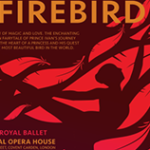 It was November 27, 1949 — opening night of The Firebird in New York City. Maria’s solo performance secured her position as the first American prima ballerina. Audiences who saw The Firebird were amazed at Maria’s technical skill. And the critics were universal in their praise. She was a new kind of dancer, with strong athleticism, clean style, and precise movements. At age 24, Maria was officially a star.
It was November 27, 1949 — opening night of The Firebird in New York City. Maria’s solo performance secured her position as the first American prima ballerina. Audiences who saw The Firebird were amazed at Maria’s technical skill. And the critics were universal in their praise. She was a new kind of dancer, with strong athleticism, clean style, and precise movements. At age 24, Maria was officially a star.
Maria’s then-husband, George Balanchine, choreographed The Firebird. He was a Russian dancer and choreographer who helped to bring classical ballet to America. He recognized Maria’s talent and they worked well together — some say he choreographed the role specifically for her dance style. The Firebird went on to become one of most successful American ballet productions. And it put both Balanchine and the New York City Ballet on the map.
 Maria’s role in The Firebird was her most difficult ever. The choreography was filled with intricate steps that showcased Maria’s talent. It was a challenge that required intense training and complete focus. Maria practiced for hours and hours, day and night. She had begun to feel ill and lost weight, but tried to push through. Finally, she went to the doctor and learned she had tonsillitis. Maria had surgery just days before The Firebird’s premiere. In fact, her throat still hurt when she arrived for the dress rehearsal the morning of the premiere.
Maria’s role in The Firebird was her most difficult ever. The choreography was filled with intricate steps that showcased Maria’s talent. It was a challenge that required intense training and complete focus. Maria practiced for hours and hours, day and night. She had begun to feel ill and lost weight, but tried to push through. Finally, she went to the doctor and learned she had tonsillitis. Maria had surgery just days before The Firebird’s premiere. In fact, her throat still hurt when she arrived for the dress rehearsal the morning of the premiere.
The Firebird was a Russian ballet — the story was based on a Russian folktale and the music was composed by Igor Stravinsky in 1910. And the Russian artist, Marc Chagall, painted the set and designed the costumes. Balanchine bought Chagall’s costumes and set designs from another ballet company for use in his production.
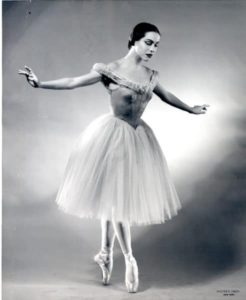
Photograph by Walter Owen
The Firebird was the first of many famous performances by Maria. In 1954, Maria starred in the role of Sugar Plum Fairy in Balanchine’s own production of The Nutcracker. Before Balanchine choreographed his version, The Nutcracker wasn’t well known or popular outside of Russia. Maria starred as the Sugar Plum Fairy, which was one of classical ballets’ most challenging roles. And she got rave reviews. Balanchine’s production quickly became the most famous version of the Russian ballet and is particularly beloved in America. Every year, it is performed by countless professional and amateur dance companies during the holiday season.
The Power of the Wand
At the height of her career, Maria was only one of four prima ballerinas in the entire world. And she was America’s first prima ballerina — before that, all prima ballerinas had been either Russian or French. Through her talent and grace, Maria helped to break down racial barriers in the world of dance. Over the years, women and girls in all areas of the arts have benefitted from the groundwork laid by pioneers such as Maria.
Pilar Hill mesmerizes audiences when she starts to play her violin. And she is only 14 years old. Pilar lives in Brooklyn, New York and began violin lessons at age 6. It didn’t take long for her parents and teachers to realize that she was a child prodigy. Today, Pilar attends the Juillard School’s Pre-College Program and practices 6-8 hours per day. Her performance received a standing ovation at the Women in the World Summit in 2019.
Her Yellow Brick Road
All her life, Maria had wanted to come a professional ballerina. So she moved to New York City in 1942 at age 17. A family friend agreed to serve as her chaperone, since she was so young. Maria enrolled in the School of American Ballet, where she continued her lessons on a full time basis. But her real goal was to dance with a ballet company and perform on stage.
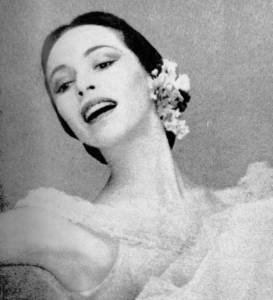
Photograph of Maria by Walter E. Owen
Soon after her arrival, Maria got an audition with the Ballet Russe de Monte Carlo. At the time, the dance company was preparing for a Canadian tour and found itself short on dancers — Europe was in the middle of World War II and no Russian dancers could travel to America. So they had to supplement their Russian dancers with Americans to complete a show. Maria’s perseverance had finally paid off.
Maria danced in the corps de ballet for the Canadian tour and had small roles at first. But she spent all her free time practicing and watching the prima ballerinas. She had a knack for picking up choreography — before long, she knew all the parts (her music background probably helped). From time to time, she was asked to fill in for soloists at the last minute. And she usually danced the roles perfectly with little practice. It was trial by fire and Maria was up to the task.
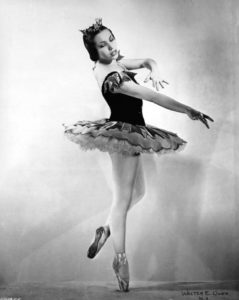
Photograph of Maria by Walter E. Owen for the Ballet Russe de Monte Carlo
Then, World War II ended and Russian ballerinas could travel to America again. So Maria went back to the corps de ballet. But she never complained. She worked harder than most dancers in the ballet company and learned every solo dance. Eventually, her work ethic propelled her into the spotlight.
Members of the Ballet Russe pressured Maria to change her name. They wanted it to sound more Russian and suggested “Maria Tallchieva.” Stage names were common among dancers back then, since many of the best dancers were from Russia. Maria was proud of her Native heritage, however, and refused to give it up. So she changed her name to Maria Tallchief. And she never looked back.
Brains, Heart & Courage
Elizabeth (“Betty”) Marie Tall Chief was born on the Osage Indian reservation in Oklahoma — she was called “Betty Marie” as a child. Her family was proud of their Native ancestry (her father was Native American and her mom was Scottish-Irish). Maria’s dad was an important leader in the tribe and her grandma taught her Osage history, folktales, music and dances.
 The Osage Nation settled throughout the Midwest, but was forced to land in Oklahoma in 1871. Then, Maria’s great grandfather negotiated the Osage Allotment Act of 1906, which guaranteed that the tribe would hold the mineral rights to their land. And it was a good thing — oil was discovered under the ground of their reservation in 1894. As a result, the Osage became the wealthiest native nation in America.
The Osage Nation settled throughout the Midwest, but was forced to land in Oklahoma in 1871. Then, Maria’s great grandfather negotiated the Osage Allotment Act of 1906, which guaranteed that the tribe would hold the mineral rights to their land. And it was a good thing — oil was discovered under the ground of their reservation in 1894. As a result, the Osage became the wealthiest native nation in America.
Maria and her siblings (Marjorie and Gerald) grew up comfortably in Fairfax, Oklahoma. Her family owned a few local businesses. Her mom was center of society, focusing on charity work and the arts. And her dad was chief of the Osage Nation. Maria took music and dance lessons with her sister, Marjorie — she started piano when she was age 3 and ballet when she was age 4. Maria’s mom wanted her to become concert pianist, but she loved to dance.
The Tall Chief family moved to Beverly Hills in 1933, when Maria was 8 years old. Her parents sought a better education for their kids (including the arts). It was a tough adjustment for Maria. She had to start all over with her ballet lessons and focus on the basics — her new teacher thought that she had a lot of talent, but was horrified at her lack of technique.
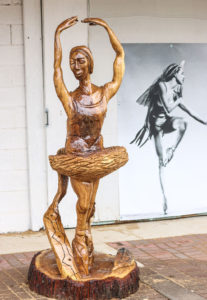
Chainsaw sculpture of Maria Tallchief by Osage artist Michael Lynn.
Maria also continued piano lessons in California (her mom still wanted her to be a concert pianist). In fact, she performed both ballet and piano during her first public performance. Finally, however, Maria’s parents let her choose between piano and dance. It was an easy decision — Maria focused on ballet and loved every minute of it.
Starting at age 12, Maria trained with Madame Nijinska (the sister of a legendary Russian dancer and choreographer). It was a good fit. Madame Nijinska was a demanding teacher and Maria was a serious student.
Maria graduated from high school in 1942. She was accepted at UCLA but didn’t want to go to college. Instead, she convinced her parents to let her move to New York City in search of a career as a professional ballerina.
Glinda’s Gallery
Just the Facts
- Maria was born on January 24, 1925 as Elizabeth Marie Tallchief. She had two siblings and three half-siblings (from her father’s previous marriage). Her sister, Marjorie, also became a professional ballet dancer.
- Maria married George Balanchine in 1946, but it was annulled in 1951 (her parents didn’t approve, since he was about 20 years older than she). Then, she married a pilot named Elmourza Natirboff in 1952. It only lasted two years, however, because he asked her to choose between him and her career (she chose ballet). Maria went on to marry Harry Paschen in 1955, move to Chicago and had a daughter, Elise.
- In 1947, Maria was the first American to perform at l’Opéra in Paris in over 100 years. She also became the first American dancer to perform at the Bolshoi Theater in Moscow in 1960.
- Maria retired from professional dance in 1966. After that, Maria was dedicated to mentoring the next generation of dancers and taught ballet in Chicago for 20 years.
- Maria and her husband helped to create the Chicago City Ballet in 1980. Maria served as the artistic director and her sister, Marjorie, joined the staff one year later. It closed when her husband stopped supporting it financially in 1987.
- Maria was famous in her home state of Oklahoma:
- June 29, 1953 was designated “Maria Tallchief Day”
- A huge mural, “Flight of the Spirit,” was installed in the Oklahoma state capitol building in 1991. It highlighted five American Indian ballerinas who achieved international acclaim, including Maria and her sister Marjorie.
- The Osage Nation honored Maria with the title, Princess Wa-Xthe-Thonba — it meant “Woman of Two Standards.”
- Maria died in Chicago on April 11, 2013.
- Maria was given many awards throughout her ballet career, including:
- National Medal of the Arts in 1999
- Lifetime Achievement Award at the 19th annual Kennedy Center Honors in December, 1996
- Oklahoma Hall of Fame in 1991
Want to Know More?
Maynard, Olga. Bird of Fire: The Story of Maria Tallchief. New York: Dodd Mead & Co, 1961.
Tallchief, Maria. Tallchief: America’s Prima Ballerina. New York: Viking, 1999.
Thomas, Heather. Maria Tallchief: Osage Prima Ballerina. Headlines & Heroes: Newspapers, Comics & More Fine Print, Library of Congress, November 19, 2019.
Osage, Oklahoma Historical Society
George Balanchine Biography, The George Balanchine Foundation
Dancing for Mr. B: Six Balanchine Ballerinas, documentary film produced in 1989.
